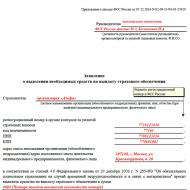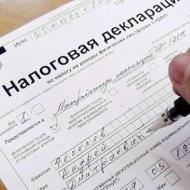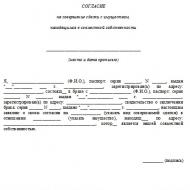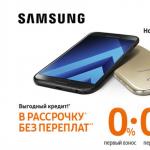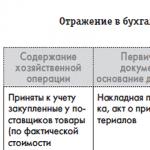
The list of cost items is approved. Accounting of production operations. Methods for calculating production costs
Directory Cost items in 1C:UPP (1C:Management manufacturing enterprise) is one of the key reference books production accounting. It is impossible to reflect a cost in accounting without specifying the cost item.
There are several classifications of costs from an economic point of view.
- In relation to the production object:
If we can attribute the cost to the manufacture of a specific product, the cost of which we calculate, then this is a direct cost. If it is not known which product the cost relates to the manufacture of, then such a cost is indirect.
In 1C:UPP, direct costs can be attributed to the manufacture of specific products using the document Shift Production Report. For example, for the manufacture of the product Kitchen Table BS-55, the material Furniture Adhesive was used in the amount of 10 kg. Cost item: Own materials.
Indirect costs at the end of the month must be allocated between outputs. For example, during the month, 50 kg of paint was used to paint products, but we cannot accurately determine how much paint was used for each product produced, so this cost is indirect and can be distributed at the end of the month among all products produced.
- Depending on production volumes, costs are divided into:
Fixed costs . These are costs whose level does not depend on production volumes. For example, the cost of renting premises.
Variable costs. The level of variable costs depends linearly on production volumes. For example, these are the costs of raw materials used to manufacture products.
Mixed costs. Their level depends on production volumes, but when production decreases to zero, these costs are not equal to zero, that is, they contain elements of both fixed and variable costs. For example, the cost of paying for telephone communications: the subscription fee is constant, and long-distance calls are paid separately.
Conditionally fixed costs. These are costs that remain constant over a certain interval of change in production volumes. For example, we paint products in batches in a chamber, each batch uses a certain amount of paint, and even if the batch is not full, the volume of paint for spraying a given batch will not decrease.
- According to the distribution space, costs are divided into:
Shop costs are costs that are distributed over the entire product range produced in a particular department. For example, depreciation costs for machines located in this department.
General operating costs are costs that are allocated to manufactured products in all departments. For example, the salary of administrative personnel is distributed among the output of all departments.
Let's look at how the "Cost Items" directory is configured in 1C:UPP.
There can be a lot of cost types, so you can create an unlimited number of cost items in SCP.


Let's look at the fillable details of the directory element Cost Items in 1C:UPP:
Nature of costs used for tasks management accounting, and can take one of the following values:

1) Defects in production: these are the costs that were attributed to the production of products that were released as unsuitable, or this is the amount of costs that went to correcting defective products.
2) Investments in fixed assets. These are not production costs. Costs arise when we create a fixed asset or repair a fixed asset. We can then write off such costs as the cost of the construction project.
3) Distribution costs and commercial expenses. These costs also do not affect production costs.
4) General production and general business expenses. These are indirect costs. General production costs are workshop costs that must be allocated to products produced in a given workshop. For example, the cost of heating a specific workshop. General operating costs are the costs of the enterprise as a whole; they are distributed across all outputs. For example, repairing a road that is used for transportation between workshops. A significant difference between these costs arises if the enterprise uses Direct Costing, then general business expenses are not distributed to the cost of manufactured products.
5) Production costs are direct costs that can be attributed to the production of specific products. For example, we can indicate how many boards were used to make a table. For example. The salary of a worker who works piecework will be a production cost, because we can say exactly how many and what kind of products he produced, the workshop manager’s salary will be a general production cost and will be distributed over the output of products produced in the workshop, and the general director’s salary will be a general operating cost and will be distributed over the output of the entire enterprise.
6) Other - do not affect the cost of production, but will be reflected in management accounting.
7) Not taken into account in management accounting - such costs will not even be reflected in management accounting, and accordingly they will not affect the cost of production either.
The nature of the cost item affects management accounting, but does not affect regulated accounting. For regulated accounting, the Cost Account specified when costs arise (for example, upon receipt of a service, or transfer of material to production) is important.
Below is a table that roughly correlates the nature of a cost item and a cost account.

Cost type. By using of this requisite you can divide all cost items by economic elements. Next, using this requisite, we will be able to determine which of the elements has a larger share in the cost of production. In this way, we can determine in which direction it is necessary to reduce costs (if necessary), and we can also determine what type of costs we will have that will determine the basis for the distribution of indirect costs.

In 1C:UPP there are 4 types of costs:
- Material. In turn, when specifying the cost type Material, another attribute becomes available - Status of material costs:

This attribute determines with what sign the cost should be included in the cost of production.
Own – the cost of such costs is included in the cost price with a “+” sign. For example, boards were transferred to production, and then they were included in the cost of the table.
Accepted for processing, these materials are not ours, therefore they do not affect the cost of our products in any way.
Returnable waste - the cost of such materials is included in the cost with a “-” sign. For example, when making a table, sawdust remained, which we later sold, then we can reduce the cost of the table by the amount of sawdust.
- Salary– labor costs;
- Depreciation– depreciation costs;
- Others- include costs that were not included in the previous groups.
For all types of costs, cost accounting is carried out, and quantitative accounting is carried out only for costs with the “Material” type.
And the last detail indicated for the cost item is Type of expenses (NU). Used to account for costs in tax accounting. You must specify the cost type for tax accounting.
Sources of costs may be the acquisition of materials with their further transfer to production, the receipt of services from contractors, the transfer of semi-finished products from the warehouse to production, the recording of wage payments, depreciation, etc.
When reflecting costs, the cost item must be indicated. For example:
Receipt of international negotiations services from the counterparty under the cost item Communications (OKR):

Reflection of administration salaries by cost item AUP salary:

Thank you!
This classification of items and elements of costs associated with production and sales was formed taking into account the requirements of Chapter 25 “Income Tax” of the Tax Code of the Russian Federation. Also, this classification of costs meets the requirements of PBU 10/99 “Organizational expenses”.
Material cost item.
This cost item combines costs material resources, arising in the process of production of products, provision of services, performance of work. The composition of material resources is classified using. The cost of material resources consists of purchase prices (excluding value added tax and excise taxes), commissions, import customs duties and fees, transportation and other costs associated with the acquisition of resources. The amount of material costs when writing off raw materials for the needs of production (performance of work, provision of services) is determined by one of the following assessment methods:
- valuation method based on the cost of a unit of inventory;
- average cost valuation method;
- valuation method based on the cost of first acquisitions (FIFO);
- valuation method based on the cost of recent acquisitions (LIFO).
The procedure for classifying an organization's expenses as material costs for tax purposes is determined in *docLink(code_content,2525,Article 254 "Material costs")*) Chapter 25 of the Tax Code of the Russian Federation.
Labor cost item.
This cost item combines the organization's expenses for wages and maintenance of employees. Type of expenses related to this article classified using .
The procedure for classifying an organization’s expenses as labor costs for tax purposes is determined in Article 255 “Labor expenses” of Chapter 25 of the Tax Code of the Russian Federation.
Cost item for depreciation of property (fixed assets).
This cost item combines depreciation deductions organizations. The type of depreciation charges is classified using the elements of property depreciation costs.
The composition of property, the depreciation deductions of which are accepted for tax purposes and relate to this cost item, is determined in Article 256 “Depreciable property” of Chapter 25 of the Tax Code of the Russian Federation.
The procedure for determining the initial, replacement, and residual values of depreciable property for tax purposes is determined in Article 257 “The procedure for determining the value of depreciable property” of Chapter 25 of the Tax Code of the Russian Federation.
The methods and procedure for calculating depreciation amounts attributed to a cost item for tax accounting purposes are determined in Article 259 “Methods and procedure for calculating depreciation amounts” of Chapter 25 of the Tax Code of the Russian Federation.
Cost item for repairs of fixed assets.
This cost item combines the organization’s expenses for repairs of depreciable property. The composition of expenses attributable to this cost item is classified using the elements of costs for repairs of fixed assets.
The procedure for accounting for an organization's expenses related to the repair of fixed assets for tax purposes is determined in Article 260 "Expenses for the repair of fixed assets" of Chapter 25 of the Tax Code of the Russian Federation. According to this article of the Tax Code, expenses for the repair of fixed assets are considered as other expenses.
Cost item for the development of natural resources.
This cost item combines the organization’s expenses for geological study of subsoil, mineral exploration, and preparatory work. The composition of expenses attributable to this cost item is classified using the elements of development costs natural resources.
The procedure for including an organization’s expenses related to the development of natural resources in the cost of manufactured products (work performed) for tax accounting purposes is determined in Article 261 “Expenses for the development of natural resources” of Chapter 25 of the Tax Code of the Russian Federation. tax code classifies expenses for the development of natural resources as other expenses.
Cost item for scientific research and development (R&D).
This cost item combines the organization's expenses related to the creation of new or improvement of manufactured products (goods, works, services). The composition of expenses attributable to this cost item is classified using elements of R&D costs.
The procedure for including an organization’s expenses related to scientific research and development in the cost of manufactured products (work performed) for tax accounting purposes is determined in Article 262 “Expenditures on scientific research and development” of Chapter 25 of the Tax Code of the Russian Federation.
Cost item for compulsory and voluntary insurance.
This cost item combines the organization’s expenses for all types compulsory insurance and voluntary property insurance. The composition of expenses attributable to this cost item is classified using the elements of costs for compulsory and voluntary property insurance.
The procedure for accounting for the costs of compulsory and voluntary property insurance included in the cost of manufactured products (work performed) for tax accounting purposes is determined in Article 263 “Costs for compulsory and voluntary property insurance” of Chapter 25 of the Tax Code of the Russian Federation. The Tax Code classifies these costs as other.
Cost item for other needs related to production and sales.
This cost item combines the organization's expenses that are not included in all of the above cost items. The composition of expenses attributable to this cost item is classified using other cost elements. To provide a greater degree of detail of the organization's expenses, the item of other costs includes clarifying cost items.
The procedure for accounting for other expenses of an organization related to production and sales for tax purposes is determined in Article 264 “Other expenses related to production and sales” of Chapter 25 of the Tax Code of the Russian Federation.
Purpose of the directory
The directory is used to maintain analytical accounting by accounts:
- 20 "Main production";
- 28 "Defects in production."
These accounts are used in organizations to summarize information about the costs of production, the products (works, services) of which were the purpose of creating this organization. Items of production costs determine the cost structure, that is, what elements it consists of, what part is for materials, what part is for labor costs, for servicing machines and equipment. The list of items is established by the enterprise independently, depending on the nature and structure of production, but it should be remembered that when taking into account costs for main activities, their grouping by economic elements must be ensured. The directory has a three-level hierarchical structure. This means that cost items can be divided into groups and subgroups. For example, for production such general groups costs like:
- "Raw materials and (or) supplies";
- "Purchased products, semi-finished products";
- "Third Party Manufacturing Services";
- "Wage";
- "Deductions for social needs";
- "Electricity costs for technological purposes";
- "Sales expenses";
- "Losses from marriage", etc.
These groups can be divided into subgroups. For example, "Deductions for social needs" detail by type of deductions, by type of service, etc. To what level you detail expenses - the level of detail available to you when drawing up reports on them.
Before entering items into the directory "Production cost items", set the necessary attributes of the organization's accounting policy. To do this, use the button "Service" on the top line of the screen. Click on this button and an action menu will open in which select the line "Accounting policy" and left click.
In the menu that opens, select the parameter value using the selection button "Base for distribution of indirect costs". This accounting policy parameter can take the following values: wages of production workers, material costs, the amount of direct costs, individual items of direct costs, revenue. Set the desired value and press the button "Install" and after setting the value, click the button "Close". If you distribute indirect costs for individual items of direct costs, then after filling out the directory you will need to mark the items for which the distribution of indirect costs will occur, written off to account 20 from account 25 and (or if you use the method "Direct costing") from account 26 at the end of the month.
Data input
To call the directory, open the window "Directories by clicking" corresponding button at the top of the screen and in the menu that opens, click the Production Cost Items button. A list of directory elements will open in front of you. "Production cost items". Initially this list is empty. Directory elements are entered in list form. A special window does not open for entering an individual element. Click a button on the command bar to enter an element or a button to enter a group. To enter a group, just enter its Name, for example, "Third Party Manufacturing Services".
Each entered group will be marked on the left with a yellow square with a sign "+" . After entering all the groups and subgroups, enter the elements themselves within the groups (subgroups). To do this, click on the yellow square to the left of the group. You will find yourself inside the group (instead of a yellow square with a "+" an open book symbol will be displayed to the left of the group).
In countries with developed market economy, as noted, accounting for production costs and cost calculation are allocated to management accounting, the task of which is to provide information for managing the cost of products to specialized specialists and the administration of the company's divisions.
In domestic practice, production cost accounting and calculation are usually an integral part of the overall unified system accounting.
A more detailed list of cost items, their composition and methods for distributing total costs by type of product should be determined accounting policy organizations.
Accounting for material costs. In this case, the following costing items are usually provided:
"Raw materials and supplies";
“Returnable waste (subtracted)”;
“Purchased components, semi-finished products and services
production nature of third-party enterprises and organizations";
“Fuel and energy for technological purposes.”
Raw materials and materials are released into production according to the standards and. drawn up with limit-fence cards, requirements, invoices. Of course, consumption refers to the direct consumption of raw materials and supplies during the production process. To control their use, the following methods are used: documentation, batch cutting, accounting and control, and inventory.
The documentation method is based on the registration in separate documents of all cases of deviations in the consumption of raw materials and materials from established norms, standards and conditions. It is used to one degree or another in all industrial enterprises.
The essence of the batch cutting method is that for each batch of materials released for production, a cutting sheet (record card) is issued. It indicates the amount of material supplied to the workplace, the amount of workpieces (parts) and waste that should be obtained from the materials, and the actual workpieces and waste received. To determine the cutting results, the actual number of blanks obtained is compared with the standard one. Savings or overconsumption are determined by comparing the amount of material actually consumed with the standard consumption. The same calculations are carried out for waste. The cutting sheet also indicates the reasons for the identified deviations and the persons responsible for cutting the materials. This method is widely used in mechanical engineering, clothing, footwear, furniture and other industries.
When using the method of batch accounting and control, batches of raw materials and supplies are formed that are uniform in technological parameters. This operation consists of selecting appropriate types of raw materials and materials and storing them separately in specially designated areas. Each batch is assigned a certain accounting attribute - batch number or name of material resources, etc.
This accounting attribute of the batch is subsequently indicated in all primary documents for accounting for raw materials and supplies used in production, which allows them to be directly attributed to specific types of products (work, services). When computerizing production accounting, it is advisable to also indicate in primary documents the code of managers who make decisions on the selection of raw materials for the corresponding batch.
Selected batches of raw materials and materials can be used for a shift, a day, several days and weeks. As the corresponding batches are used, they are usually made operational-production or monthly production reports, as well as summary technical reports on the use of raw materials and materials in production.
This method is used in organizations of the chemical, petrochemical, chemical-pharmaceutical and food industries, organizations of ferrous and non-ferrous metallurgy.
With the inventory method, after a shift or other period, an inventory of the remaining raw materials and materials is carried out. The actual consumption of raw materials and materials for production is determined by adding them to the balance of raw materials and materials at the beginning of the period of their receipt and subtracting the balance of raw materials and materials at the end of the period from the resulting amount.
The standard consumption of raw materials and supplies is determined by multiplying the produced products by the rate of consumption of raw materials and materials. Their actual consumption for each calculation group is compared with the standard one and deviations from the norms are established, which are then distributed among the corresponding cost accounting objects, in proportion to the standard costs, and the cause and culprits of the identified deviations are determined. To systematize and analyze deviations from the norm, organizations develop a list of causes and identify possible culprits.
This control method is widely used in meat, dairy, Food Industry, as well as in metallurgy, electric power, and the chemical industry.
After one month, the workshop prepares reports on the consumption of raw materials and materials, which indicate the standard and actual consumption of materials for each type of product or for several types of it in general. The reports explain the reasons for overspending or savings. Based on shop reports, the accounting department draws up for each synthetic account separately statements (machine diagrams) of the distribution of materials, where the consumption of raw materials and supplies is reflected for each analytical account, opened in the development of synthetic production accounts.
In many industries and industries, the distribution of raw materials by type of product is carried out directly, since the primary documents on their consumption indicate the type (code) of the product. However, in a number of industries and industries, raw materials and materials are spent on a group of products, therefore they are distributed by type of product in an indirect normative or coefficient way.
With the standard method, the actually consumed raw materials and materials are distributed among types of products in proportion to their consumption according to the norm.
The consumption of auxiliary materials is taken into account in the same way as the main ones. However, they are distributed among the objects of calculation indirectly: in proportion to the estimated rates established per unit of production based on the rate of their consumption and planned cost. If the costs of such materials are significant, they can be separated into a separate costing item. In this case, the cost of consumed auxiliary materials is distributed between types of products in the same way as the cost of basic materials.
Returnable waste is received by debit 10 with crediting accounts 20 and 23.
The article “Purchased components, semi-finished products and production services of third-party enterprises and organizations” reflects the costs of purchased products and semi-finished products used by this organization to produce finished products. This article also includes costs for payment for production services provided by third parties, which can be directly attributed to the cost of individual products.
To control the use and movement of semi-finished products, an operational balance of the movement of semi-finished products is drawn up, in which for each type they reflect the balance in the workshop at the beginning of the month, receipts for the month (manufactured in the workshop, received from the warehouse, to the scrap board), consumption for the month (also by direction ) and the balance at the end of the month. When conducting an inventory, the actual balances on the balance sheet are compared with the accounting balances and the reasons for the discrepancies are clarified.
Purchased semi-finished products are intended for the production of specific products and are usually directly attributed to these products. If direct accounting is not possible, purchased semi-finished products are distributed among products using the methods specified for the distribution of raw materials and basic materials.
Under the article “Fuel and energy for technological purposes” they reflect
cost of consumed fuel, electricity, oxygen
other energy resources, hot and cold water, steam, compressed air
spirit, cold, directly consumed in the production process
products. I
The consumption of various types of energy in individual workshops and other areas is determined by meters and instruments. In their absence energetic resources distributed among the relevant objects in proportion to the number of machine hours worked, estimated rates per unit of production, etc.
The cost of fuel and energy resources is distributed in a special statement of services provided auxiliary production and farms. Energy costs are distributed based on standards and prices.
The specified resources used for technological purposes are debited to accounts 20, 23 and 29 " Service industries and farms" with credits 10, 23 and 60. The consumption of purchased electricity for technological purposes is recorded by posting:
Debit 20 Credit 60.
The cost of fuel and energy used for equipment maintenance and business needs increases the debit turnover of Accounts 25 and 26.
Accounting for labor costs and social contributions. Under the article “Labor costs”, the wages of production workers and engineering and technical workers, whose work is directly related to the production of products, the performance of work and the provision of services, are planned and taken into account.
To distribute wage amounts among cost accounting objects, they are grouped according to data primary documents for accounting of labor and its payment (work orders, reports, statements, route sheets, etc.) for workshops, processing areas, sections and other accounting objects. Within each accounting object, wages are grouped by calculation objects. Grouped data about wages recorded in accumulation cards or statements opened for each accounting and calculation object. Based on the data from the savings cards, a development table is drawn up
(machine diagram) of wage distribution. In small organizations, such tables can be compiled directly from the data of primary documents for recording production and payroll statements.
The main part of the wages of production workers is included in the cost of individual types of products or their homogeneous types directly; that part of the wages that cannot be attributed in this way to the cost of individual products is distributed indirectly in proportion to the estimated rate of these costs per unit of production.
The entire amount of accrued wages for production workers is divided into two parts: wages according to norms and deviations from norms. The latter are identified, as a rule, by the documentation method, the essence of which is that wages within the norms are accrued to workers according to accepted documents. Wages are calculated in excess of the norms according to specially issued documents - sheets for additional payment, orders for performing work not provided for by the technology, sheets for recording downtime, orders for correcting defects. Deviations in the wages of workers paid on a time basis are identified when distributing accrued amounts in proportion to standard rates by comparing the actual accrued wages with the standard amount.
To control wage deviations, it is advisable to draw up a statement (machine diagram) of deviations over five-day and ten-day periods.
The article “Deductions for social needs” includes the amount of the unified social tax, contributions of organizations for mandatory social insurance from accidents at work and occupational diseases, made in accordance with the legislation of the Russian Federation, as well as corresponding deductions (payments) for voluntary types insurance, pension provision from the amounts of wages recorded under the item “Labor costs”. Corresponding taxes (deductions, payments) from wages included in general production costs, general expenses, expenses of auxiliary production and other similar expenses are also taken into account as part of these expenses.
Contributions for social needs are distributed by type of product in proportion to the amount of wages accounted for under the item “Labor costs” (with the exception of those types of wages for which insurance premiums are not credited).
Accounting for the costs of preparation for the development of production. The article “Expenses for preparation and development of production” includes the following costs:
for the preparation and development of new organizations, production facilities, workshops and units taken into account from the beginning of the current active organization, workshop or the use of new units in the current activities of the organization;
for the preparation and development of production of new types of products and new technological processes;
for the development of natural resources, preparatory work
nature at developed fields in the mining industry
industry;
other one-time costs, the list of which varies by industry.
The range of starting costs depends on the nature of the tests. The amount is determined by the estimate. Start-up costs are included in the cost of certain types of products according to repayment rates. Their write-off and inclusion in current costs is documented by posting:
Debit 20 Credit 97.
Accounting for production maintenance and management costs. Such expenses include the costs of maintaining and operating machinery and equipment, general production and general business expenses. The first two types of them are included in the cost of production under the item “General production expenses” and are taken into account in synthetic account 25; General business expenses are recorded on the account and included in the cost of production under the item “General business expenses.” On the debit of these accounts, expenses are reflected during the month; on the credit, expenses are written off to production accounts. After the end of the month there are no balances on these accounts.
However, the costs of maintaining and operating equipment are considered semi-variable or conditionally variable, i.e. depending on the volume of production, and general production and factory expenses are constant, i.e. independent of the volume of production. In addition, as part of general business expenses, the size of many of them is regulated by the state for tax purposes.
Expenses for the maintenance and operation of machinery and equipment are usually taken into account in the first subaccount of account 25.
At the end of the month, expenses for the maintenance and operation of equipment are written off from accounts 20 and 28 (in terms of correctable defects) and distributed between individual types of products and work in progress. On the second subaccount, account 25 records expenses for maintenance, organization, management structural unit(workshop, production, etc.).
In small organizations, you can refuse to separately account for the costs of maintaining and operating equipment and other general production expenses. In this case, the organization independently establishes the nomenclature of overhead items, highlighting the most significant ones. It is advisable to assign these expenses to cost centers and responsibility centers to strengthen control over them. For small shops of auxiliary production, general production costs are usually taken into account directly on account 23. As the basis for the distribution of general production costs, the costs of paying workers are used, production costs without the cost of raw materials and supplies, direct costs certain species products, production volume, etc.
Expenses common to the entire organization are recorded on active synthetic account 26.
At enterprises with good technical equipment, where normative and estimate work is carried out at a high level and, therefore, normative (planned) calculations are developed in accounting policy It is necessary to provide for an accounting procedure using account 40 “Output of products (works, services)”. It is designed to account for manufactured products and identify deviations in actual production cost from the normative (planned) one. The use of this account allows you to eliminate labor-intensive calculations for the distribution of general production and general business expenses between products, as well as calculations for determining deviations of the actual cost from the planned one for finished, shipped and sold products.
During the month, manufactured products are received at standard (planned) cost by compiling an accounting entry
Debit 43 Credit 40.
Actual production cost at the end of the month. After its calculation, account 40 is debited from account 20 as a credit. Naturally, at the end of the month, a balance is formed on account 40: debit or credit. A debit balance will be formed when actual costs exceed standard costs. The following entries are made for the amount of this balance:
Debit 90 Credit 40.
A credit balance of account 40 means that the company has achieved a reduction in production costs. In this regard, the above posting is compiled with negative numbers (using the “red reversal” method):
Debit 90 Credit 40.
As follows from the above, account 40 does not have a balance, finished products are accounted for at standard (planned) cost, and the balance of account 40 reduces or increases sales income.
A special accounting procedure is used for settlements in organizations carrying out long-term work (design, construction, etc.). The specificity of the activities of such contractors is that they have finished products is not accepted for registration and they need to receive Money according to the intermediate readiness of order fulfillment.
Information about the contractor’s completed stages of work is summarized on account 46 “Completed stages of work in progress.” The debit of this account reflects the cost of completed stages of work accepted by the customer in correspondence with the credit of account 90. Upon completion of all stages, account 46 is credited with the debit of account 62. The cost of fully completed work, recorded on account 62, is repaid in cash. A debit balance can be formed on account 62, meaning the amount of work completed but not yet paid for.
Actual costs by stages are reflected in the debit of account 90 and the credit of account 20, and the receipt of payments is reflected in the debit of accounts 50 “Cash”, 51, 52 “Currency accounts” and the credit of account 62.
Perhaps the topic of costs is one of the most important in the life of a company. Neither company owners nor tax office. For some, extra costs mean a decrease in profits. For others, unreasonable expenses are understatement of taxes. The topic of cost accounting in accounting is very extensive, but let’s get acquainted with it in this article.
The concept of Costs..., but is it the same?
Reading books and textbooks on accounting, you will find that together with the concept of Costs, the concept of Expenses is often found. Yes, so often that they sometimes even appear together in the same sentence. You can think about the equality of these concepts. However, there is a fundamental difference between them.
Costs in accounting- this is a decrease in the resource of the enterprise, but without its loss. Resources such as money, materials, or others are exchanged for another resource or obligation. For example
: They paid the supplier in money for previously received materials - “the money turned into materials.” Or they could first pay the supplier and thereby “fix” his obligation to us.
In any case, the resource “money” is not lost, but “transformed” either into materials or into an obligation.
Expenses in accounting- this is the irrevocable conversion of the company's resources to obtain Revenue. For example : Sold the goods and handed them over to the buyer. At this point, the cost of the goods is considered an Expense for the company.
Now that the fundamental difference between these concepts has been defined, you should be attentive to the events taking place at the enterprise so that for the words Costs and Expenses you clearly understand what their meaning is.
Names of Cost items and their groups
Every enterprise, trying to make money, is forced to spend money and incur costs. The specific list of such costs varies among firms, but there are some common ones. For example, “office”, “employee salaries”, some types of taxes, “cartridge refilling”, “electricity”, “utilities”, “premises rental” and many, many others. Look at the list of specific cost items used in two operating businesses.
list of cost items
cost items list
As you can see, the list is unlimited: the names of cost items depend on the accountant. Of course, three conditions must be adhered to:
a) the name should reflect the essence of the costs,
b) too much detail in articles provides a detailed analysis, but increases the complexity of registration,
c) a too general name for a cost item makes the work easier, but the possibility of detailed analysis is lost.
Along with the names of cost items, it is possible to combine them into groups. What name should I give to the group? This question is always relevant for companies. Accounting suggests assigning each cost to one of five groups: " Material costs", "Depreciation", "Labor costs", "Payroll taxes", "Other".
If we take these five groups as a basis, then we will certainly lose a detailed cost analysis, since these groups are too generalized. The following SALT by Account report shows what the collected costs will look like.
Balance sheet only by cost groups
For accounting purposes this may be sufficient. But for analysis of the activities of the enterprise, for the possibility management decisions in such groups detail is lost. The way out of this situation will be a special technique for filling out a list of costs. If we take the 1C Accounting program as a basis, then the “List of Costs” directory can be filled out as follows.
Directory of cost items by group
In each group that accounting offers us, we can enter any name of a cost item, thereby maintaining detail and the possibility of detailed analysis. Now the "Account SALT" report may look like this.
Balance sheet by groups and cost items
Accounting Accounts for Costs and Expenses
To account for Costs in accounting, you can find a whole list of accounts. If you write down the most basic ones, the list will be like this: 20, 25, 26, 44, 91.2, 90.2, 90.7-90.8. And this is what the settings for these accounts look like in the 1C Accounting program.
Chart of accounts - list of cost and expense accounts
Cost and Expense accounts work on the principle of collecting data and transmitting it to financial results. For most organizations, data is collected within a month. And on the last day, the collected Costs are transferred in a certain way to the financial result (closing the month).
For some accounts, this path goes straight into the financial result formula. For others, this path is not always straight. It also happens that the Cost account in some cases goes directly to the financial result, and in others it goes a long way.
For example
.
Account 44 goes to the financial result, to 90.7.
Account 91.2 is already a participant in the financial result formula.
Count 26 in some cases will go to 90.8, in other cases it will go to 20 and there it will be “lost/included” in the cost of the products received. And when the products are sold, this cost will move to 90.2.
The 25 count also goes to 20 and is “included” in the cost of production.
Account 20 transmits its data in different ways. In some cases, the data goes to account 40, in others to 43 and even immediately to 90.2
The number of cost accounts a company uses depends on the type of activity. The most common situations are presented in the table.
Actions with Costs and Expenses
Many different events occur in the life of a company. For events related to Costs and Expenses, you can highlight the following types: a) direct purchase, b) now Expense, future Expense, c) mandatory Expenses, d) Closing the month.
"DIRECT BUY". These are situations where a company, when making purchases from a supplier, immediately charges the amounts to cost accounts. The most common are the purchase of a small amount of office supplies, refilling cartridges, rental of premises, communication services, etc.
“NOW A COST, IN THE FUTURE AN EXPENSE” These are situations where the path to the Cost and Expense accounts lies through previous transactions.
A good example is material values. First, we buy them and record them in the appropriate accounts. However, material assets can deteriorate, can serve as raw materials and will be transferred to production, can be sold, or can be used for economic activity companies. In these cases, the cost material assets begins to influence financial results. The influence occurs due to the fact that their value falls into the Cost and Expense accounts and further into the financial result formula.
How it looks in the postings, look in the table
Another example is unfulfilled obligations. The company’s interaction with counterparties is based on the “product/service – money” relationship. Since this relationship is not instantaneous, a gap arises, which can be called obligations. Depending on the situation, the counterparty may have obligations to our company, or it may be the other way around - the company owes the counterparty.
Here are two common situations.
1. Our company paid the supplier and did not receive its product/service.
2. Our company sold (sold) a product/service to a counterparty-buyer and did not receive payment.
If debts are not repaid, then over time they may be recognized as debts that are unrealistic for collection or for which the term has expired limitation period. The company will attribute these amounts to other Expenses and it turns out that it has lost its resources.
How it looks in the postings, look in the table
The list of other Expenses is wide and requires separate study.
"MANDATORY COSTS" If we assume that the company knows how to conduct business without using the direct purchase of Costs and Expenses, there will still be situations within the company where Expenses are necessarily present. Such mandatory expenses include: a) depreciation, b) wages, c) payroll taxes, d) some taxes.
How it looks in the postings, look in the table
"CLOSING OF THE MONTH" The final result of all actions with cost and expense accounts will be the “closing of the month” event. It occurs once a month and is the very last among all actions.
The purpose of the "Month Closing" event is to carry out two regulatory actions with cost and expense accounts and one with financial result accounts.
The first action is according to certain rules
collect additional amounts for cost and expense accounts.
Second action - according to certain rules
transfer the collected amounts to the financial result accounts.
The third action is to calculate the Financial result on the corresponding accounts and get the total on account 99.
What does it generally look like in the wiring?
|
Debit |
Credit |
Basic steps |
|
Depreciation of fixed assets and intangible assets (we are collecting more) |
||
|
Future expenses (we are collecting more) |
||
|
20,25,26, |
Accrual of interest on loans and credits (we collect more) |
|
|
Calculation of taxes from payroll (we collect more) |
||
|
Production costs are collected (closing 25 accounts) |
||
|
Production costs are collected (closing 26 accounts) |
||
|
Closing 20 accounts |
||
|
Additional accrual of actual cost for sold products released in the current month |
||
|
Transfer of collected management expenses |
||
|
Transferring collected expenses to sales |
||
|
Income - financial result for core activities |
||
|
Loss - financial result for core activities |
||
|
Income - financial result for NON-core activities |
||
|
Loss - financial result for NON-core activities |
As a result, the final Financial result will appear on account 99.
Profit if there is a credit balance on account 99.
Loss if there is a balance in Debit on account 99.
Not a single company can do its business without Costs. The topic of costs plays a key role in accounting. After all, future analysis and decision-making depend on coming up with the structure and names of Costs. The result in the financial result formula and, of course, taxable profit depend on the amount of Costs. Activities dictate their accounts for the accounting of Costs and Expenses. Moreover, each cost accounting account has a set of rules for how it should be closed to the financial result.
Let's start learning the basics of accounting with the cash section. One of its representatives is the accounting of funds in a current account. Perhaps this is the simplest......

